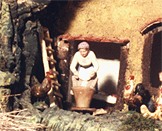|
If you have not put away your crib on 6th January evening, you can
do it today, 2nd February, or also tomorrow San Biagio's day.
In fact, the traditional dates to put away the
crib, set at the end of November of the previous year, are
the 6th January, God's Epiphany, the 17th January, Sant'Antonio Abate's
day, or the 3rd February, Saint Biagio's day. They are days that
celebrate the old Saints, just as near Christmas there are
days that celebrate Young Saints (Santo Stefano, SS. Innocenti
and
San Giovanni Evangelista)
They are not casual events: Christianity, replacing the old
pagan religions, has not abolished the antique celebrations of nature
that celebrated the passage from the old year to the new one and
the awakening of the generating forces of nature after the
hibernation of the winter months, but it has given them a
different meaning, moving the struggle between the good and evil
from the physical level (good is what gives life, evil is what
opposes the life) to the level of spirit, where good and evil
are considerated in an ethics dimension.
In
particular, Greek and Roman were afraid of the month of
February: the spring forces are being awaked, but the icy lies
still in wait. So they made several rituals to avoid the dangers
linked to the birth of the young vegetation and to the
contamination for the coming back of the died souls who, by
opening of the bosom of the earth, left their underground home
and came to visit the region of the living. The month of
February (februarius, in latin) takes its name from the rites of
"purification" (lat. februum), that were necessary to
protect the living from this coming back that contaminated, but
also guaranteed the fecundity of the women and the earth.
|

|
This set of meanings breaks out on the Neapolitan crib in the
triad made up of the hunter, the shipman and the washerwoman;
they are three characters who, as we have already told, cannot
be absent on the traditional crib.
|
|
The
figure of the washerwoman, in particular, is interesting. In the
scene of the Nativity it looks like a "midwife":
waherwoman and "midwife" have got a clear
meaning of "purification".
|

|
In
the next number, an article of D. Assante will analyse some
pictures where there is the figure of the washerwoman, while I
will speak about the crib and its characters: in particular
about Saint Joseph and also Saint Biagio. Dear readers, I will
always speak in this desultory manner that someone will consider discontinuous, but I hope you will not dislike
because it gives my talking the real character of a conversation
among friends.
In
this number, I suggest you an article of my old book In Limine that
represents a fundamental stage in my reflections.
|



